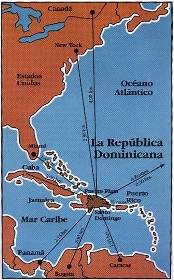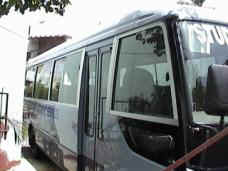|
|
|
 Airports
and highways--The
Dominican Republic boasts an inordinate number of airports for such a relatively
small island nation--8, with more on the way and several of the existing
airports in the process of expansion. The largest and busiest airport is Las
Americas, just east of the Capital, which also has the smaller Las Herreras
airport. Cajuiles and Punta Cana airports service the huge, all-inclusive
resorts on the eastern coast; and there are airports to the west in Barahona; in
the central heartland of Santiago, in Puerto Plata on the north coast and in the
northeast at Samaná.
Airports
and highways--The
Dominican Republic boasts an inordinate number of airports for such a relatively
small island nation--8, with more on the way and several of the existing
airports in the process of expansion. The largest and busiest airport is Las
Americas, just east of the Capital, which also has the smaller Las Herreras
airport. Cajuiles and Punta Cana airports service the huge, all-inclusive
resorts on the eastern coast; and there are airports to the west in Barahona; in
the central heartland of Santiago, in Puerto Plata on the north coast and in the
northeast at Samaná.
Modern highways connect the airports to all of the surrounding cities and towns, and the cities and towns to each other. No doubt the most important highways are Las Americas, which connects the Capital to the main airport, and the recently renovated Autopista Duarte that heads north from the Capital to Santiago and then to Puerto Plata on the northern coast. Autopista Mella is the main artery for the southeastern region, and Autopista Sánchez, also known as 30th of May, for the southwest. (Note that three of the major highways are named for the three "fathers" of the independent Dominican Republic; 30th of May, 1961, is when the dictator Rafael Leonidas Trujillo was assassinated on the Autopista Sánchez just outside the Capital.)
Rental
cars vs. public transportation--Cars,
trucks, buses, motorcycles, mules and horse-drawn carts of all descriptions
share the Dominican Republic's major highways and the smaller connector roads,
which are lined with dogs, goats, road-side stalls, drying produce such as rice,
cocoa and copra (from coconuts), as well as with chatting groups of people and
pedestrians of all ages. People are always on the go here. You will probably
find it more enjoyable to travel by bus or other public transportation, rather
than to rent a car, for routes are not clearly marked and rules of the road are
not strictly enforced, making driving tense and chaotic for those who are not
accustomed to it. The buses here, especially the large ones run by such
companies as Metro, Caribbean Tours, Espinal, and Terrabus are well maintained
and comfortable--they usually have on-board bathrooms, are air conditioned
(generally, the complaint is that they are too cold, so take along a sweater),
and most show recently released movies on board, usually in English with Spanish
subtitles. Along the most frequently travelled routes like that from the Capital
to Puerto Plata, buses leave every half hour. The north/south run takes
approximately 4 hours, including one rest stop, and costs less than RD$100.
There are also smaller buses and bus-vans that run between the cities and towns.
Many of them are not air conditioned and they don't show movies, but they do
have great music, which is usually played far too loud for non-Dominicans. They
also squish several more people together across the bench seats than Europeans
and Americans are accustomed to in order to keep the prices down (fares average
RD$3-20). They're great bargains for students and other cost-conscious
adventurers, however, and far more "typical" than the big buses--you
might find yourself sitting next to someone carrying a live chicken, or pressed
into holding an adorable child, because children who sit on laps ride free and
because children here are not taught to be afraid of strangers.
enjoyable to travel by bus or other public transportation, rather
than to rent a car, for routes are not clearly marked and rules of the road are
not strictly enforced, making driving tense and chaotic for those who are not
accustomed to it. The buses here, especially the large ones run by such
companies as Metro, Caribbean Tours, Espinal, and Terrabus are well maintained
and comfortable--they usually have on-board bathrooms, are air conditioned
(generally, the complaint is that they are too cold, so take along a sweater),
and most show recently released movies on board, usually in English with Spanish
subtitles. Along the most frequently travelled routes like that from the Capital
to Puerto Plata, buses leave every half hour. The north/south run takes
approximately 4 hours, including one rest stop, and costs less than RD$100.
There are also smaller buses and bus-vans that run between the cities and towns.
Many of them are not air conditioned and they don't show movies, but they do
have great music, which is usually played far too loud for non-Dominicans. They
also squish several more people together across the bench seats than Europeans
and Americans are accustomed to in order to keep the prices down (fares average
RD$3-20). They're great bargains for students and other cost-conscious
adventurers, however, and far more "typical" than the big buses--you
might find yourself sitting next to someone carrying a live chicken, or pressed
into holding an adorable child, because children who sit on laps ride free and
because children here are not taught to be afraid of strangers.
Within the towns and cities, there are many inexpensive options for public transportation. There are large city buses, large and medium-sized privately administered buses, and bus-vans that run on regularly scheduled, interconnecting routes. There are also public cars called publicos or conchos that travel specified routes; which way the driver is going is indicated by one of several signals he makes that regular concho-users recognize, such as thumb up, thumb down, waving straight ahead, etc. Each passenger pays RD$5-10 (depends how far they are travelling) and gets on or off wherever they want along the route. Conchos are ridiculously cheap transportation, but one pays in terms of comfort--the drivers squish passengers four across in the small back seats and two together in the front passenger seat.
Taxis--Taxis are relatively inexpensive, even in the Capital, where they cost more than outlying towns. Although rides are not metered, there are set rates, averaging RD$50-100 from point-to-point within the Capital and approximately RD$350-500 from the airport to most hotels. Note that rates are less expensive for the radio-controlled cars (Apolo, Anacaona, Taxi Express, Maxi Taxi) than for non-radio controlled cars, because they can pick up fares wherever they let you off. Taxi drivers who are "stationed" at particular hotels or at the airport, for example, have to return to their stations to pick up their next fare, which is more expensive in terms of time and gas consumption. The tourist taxis--the new beige cars that approved taxi drivers purchased with special government-backed loans--are the most expensive, but also the most comfortable and reliable. In smaller towns and at rural crossroads, moto-taxis or motos--motorcycles that carry 1-2 passengers each for approximately RD$5-10--are a fun and cost-effective way to travel. Taxis and motos are also available by the hour or by the day at reasonable rates; taxis in the Capital, for example, charge RD$150 per hour, which is negotiable for longer lengths of service. Unfortunately, Dominican taxi drivers have gotten a bad rap over the years for overcharging tourists. If you stick to the beige tourist taxis and the "company cars" (drivers who work for one of the radio-controlled chains), you will seldom encounter a problem. If you hail any old taxi passing by, however, you are best advised to negotiate a price to your destination before entering the cab.
Rental cars--Rental cars are readily available from local firms as well as from established international chains (Budget, Honda, Nelly, McDeal, Metro); prices average US$75-100 per day. Any visitor aged 25 or more with a valid international drivers license (all U.S., Canadian and most European drivers licenses qualify) may drive in the Dominican Republic for up to 90 days, the maximum length of time for a Visitors Visa. If you will be staying for a longer period of time, you will have to prepare and submit an endless series of papers requesting permission to drive here; hire a lawyer to prepare and submit them for you.
Speed
limits are not generally posted, but are 80 kph on the highways, and from 40-60
kph in the urban areas.